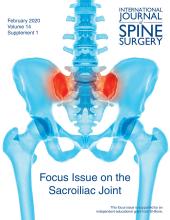ABSTRACT
Background: The sacroiliac joints (SIJs), the largest axial joints in the body, sit in between the sacrum and pelvic bones on either side. They connect the spine to the pelvis and thus facilitate load transfer from the lumbar spine to the lower extremities. The majority of low back pain (LBP) is perceived to originate from the lumbar spine; however, another likely source of LBP that is mostly overlooked is the SIJ. This study (Parts I and II) aims to evaluate the clinical and biomechanical literature to understand the anatomy, biomechanics, sexual dimorphism, and causes and mechanics of pain of the SIJ leading to conservative and surgical treatment options using instrumentation. Part II concludes with the mechanics of the devices used in minimal surgical procedures for the SIJ.
Methods: A thorough review of the literature was performed to analyze studies related to normal SIJ mechanics, as well as the effects of sex and pain on SIJ mechanics.
Results: A total of 65 studies were selected related to anatomy, biomechanical function of the SIJ, and structures that surround the joints. These studies discussed the effects of various parameters, gender, and existence of common physiological disorders on the biomechanics of the SIJ.
Conclusions: The SIJ lies between the sacrum and the ilium and connects the spine to the pelvic bones. The SIJ transfers large bending moments and compression loads to lower extremities. However, the joint does not have as much stability of its own against the shear loads but resists shear due the tight wedging of the sacrum between hip bones on either side and the band of ligaments spanning the sacrum and the hip bones. Due to these, sacrum does not exhibit much motion with respect to the ilium. The SIJ range of motion in flexion-extension is about 3°, followed by axial rotation (about 1.5°), and lateral bending (about 0.8°). The sacrum of the female pelvis is wider, more uneven, less curved, and more backward tilted, compared to the male sacrum. Moreover, women exhibit higher mobility, stresses/loads, and pelvis ligament strains compared to male SIJs. Sacroiliac pain can be due to, but not limited to, hypo- or hypermobility, extraneous compression or shearing forces, micro- or macro-fractures, soft tissue injury, inflammation, pregnancy, adjacent segment disease, leg length discrepancy, and prior lumbar fusion. These effects are well discussed in this review. This review leads to Part II, in which the literature on mechanics of the treatment options is reviewed and synthesized.
Footnotes
Disclosures and COI: Work supported in part by the National Science Foundation Industry/University Cooperative Research Center, University of California at San Francisco and University of Toledo and research grants from SI-Bone, Inc. Santa Clara, California.
- ©International Society for the Advancement of Spine Surgery
- This manuscript is generously published free of charge by ISASS, the International Society for the Advancement of Spine Surgery. Copyright © 2020 ISASS.







